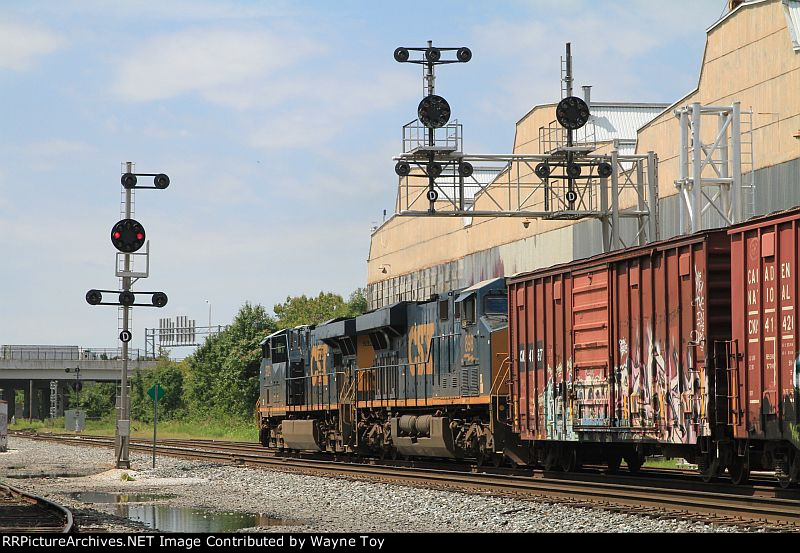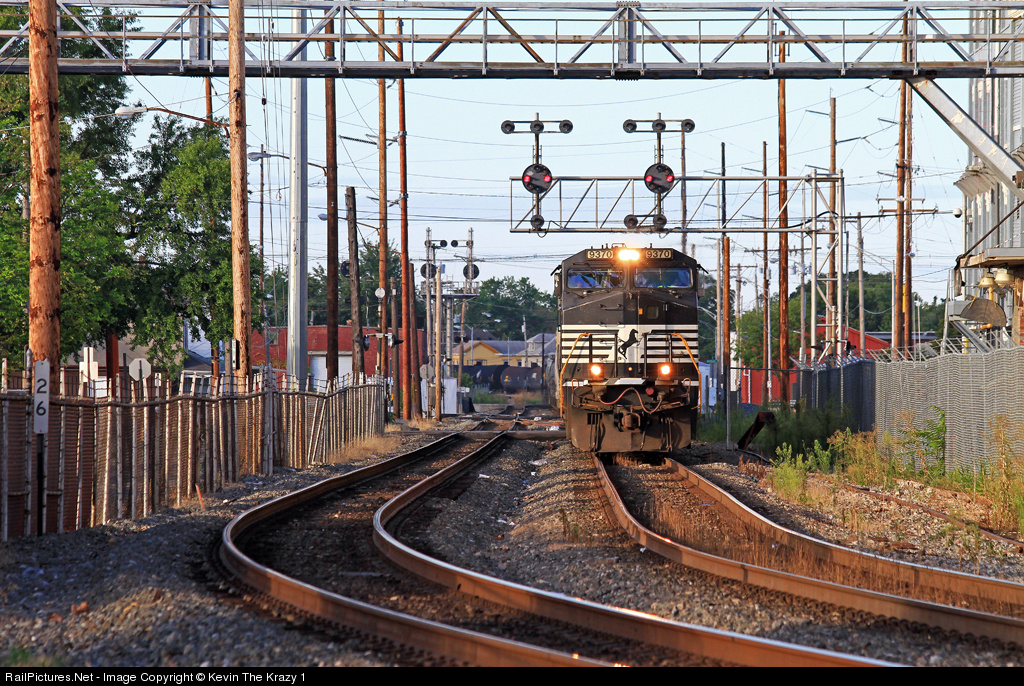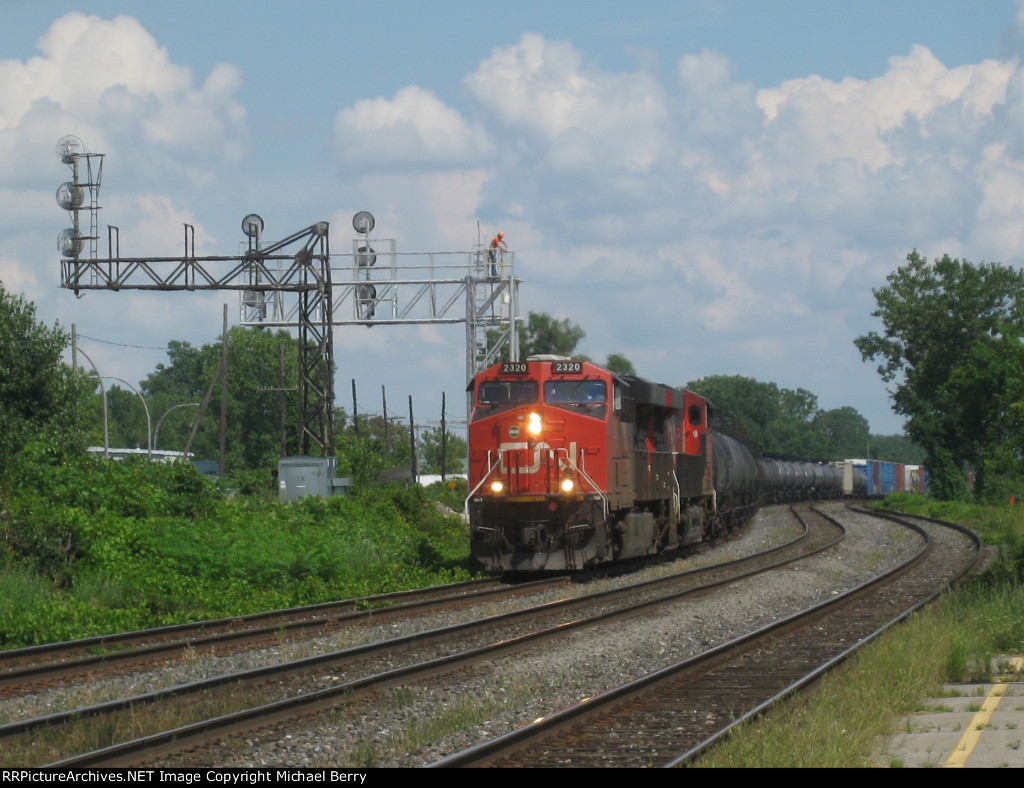Once again it appears that the Complete B&O CPL is one again headed for extinction. These most rare of signals is the B&O style CPL with all 6 orbitals and a complete central target with all 4 lamp pairs (G,Y,R,LW). As far as I could ever determine there only used to be 2 of these, one in Curtis, IN and the other in Laughlin Jct, PA. The first bit the dust ~2000 when the B&O Main Line to Chicago was re-signaled in the wake of the Conrail merger. The second then fell in 2004/5 when Glenwood interlocking was removed from service on the P&W.
Then in 2007 a miracle occurred. A capacity improvement project at West Baltimore triggered an upgrade of the 1992 installed westbound CPLs at CARROLL interlocking with one main track getting a plus up to 5 orbitals and another to 6 and like the coelacanth, the B&O complete CPL was back from the dead. Unfortunately, a short 5 years later CSX abandoned all efforts to reuse any old signaling hardware, even if it was not life expired and in the case of the Capitol and Metropolitan subs had no incentive to do so as it was awash in stimulus money to upgrade the MARC commuter rail service. The result is a brand new, modern and recently upgraded CPL signal now facing retirement and forcing the complete CPL back into extinction. What a fucking waste of tax dollars.
As far as I can tell the next best CPL is a 5-orbital model in Hamilton, OH, although the head lacks a Lunar indication. If anyone reading this knows of anything better let me know.
A blog devoted to explaining the ins and outs of North American railroad signaling, past, present and future. This blog seeks to preserve through photo documentation the great diversity and technical ingenuity of 20th century signaling and interlocking hardware and technology. Related topics cover interlocking towers and railroad communications infrastructure.
Note, due to a web hosting failure some of the photos and links may be unavailable.
Search This Blog
Tuesday, August 21, 2012
Sunday, August 5, 2012
Canadian Pacific Mystery Searchlights
A year ago I posted about the new searchlight signals being installed by the Canadian Pacific at their rebuilt Mechanicsville Yard.While the CP ultimately became rather inconsistent about its new searchlight policy it seems that there is a bit of a wrinkle to the plot. I recent came across some photos about a new, new searchlight installation in Canada, this time with some closeups of the searchlights themselves and it confirmed something I had suspected for some time. CP is not installing either recycled "classic' style searchlights or their modern replacement Unilens or tri-LED type searchlights. Instead what is going in is something that looks like a classic searchlight, but has a much larger housing and the light output of an LED signal. You can see here in this photo of the most recent instalation being put into service.
Compare them to the classic US&S H-2 units they are replacing.
I will look into this. It would be great if modern solid state searchlight signals could finally take off and provide some much needed competition for those god damn Darth Vader signals.
Compare them to the classic US&S H-2 units they are replacing.
I will look into this. It would be great if modern solid state searchlight signals could finally take off and provide some much needed competition for those god damn Darth Vader signals.
Wednesday, August 1, 2012
VIDEOS: Pennsylvania Railroad Cab Signaling Demonstration
I've talked about the 4-aspect PRR Cab Signaling System before, but this time I have a really good video demonstration of how it works in practice. As you know the system uses coded track circuits with pulses of 100Hz current sent through the running rails at rates of 180, 120, 75 and 0 pulses per minute which provide the cab signals of Clear, Approach Medium, Approach and Restricting. These roughly correspond with the 4 main speeds of railroad operations, Normal, Limited, Medium and Slow. As there are about 20 signal indications displayed on wayside signals and only 4 cab signals, the cabs provide only a rough indication of what the engineer can expect, but the system is set up in such a way so that it can forestall most grossly unsafe conditions, especially when outfitted with speed control.
So what better way to demonstrate the PRR Cab Signaling System than to bring you a video taken in the cab of one of the last passenger cars purchased for use by the PRR. On June 29th, 2012 the 1967 vintage Silverliner III class EMU, along with the 1963 vintage Silverliner II class EMU made their final runs on the SEPTA Cynwyd Line service. I was take to stand in the cab and get some video of the engineer operating the train from the Cynwyd Station in towards 30th St Station in Philadelphia. The cars are equipped with a Modernized Cab Display Unit, installed during an early 1990's rehabilitation. This still display the PRR miniature position light signal indication, but also include an integrated speedometer for the speed control function as well as other lights for overspeed and brake suppression. The train starts in non-cab signal territory, but as it passed the signal at CP-JEFF (4:27) it passes a cut-in loop (4:55) and the display activates (5:00). The cab signals then begin an automatic test sequence running through each aspect before returning to the one respecting the code in the rails (6:00).
There is a slow speed switch onto the main line with a wayside signal displaying Slow Approach (6:38). This translates to a Restricting cab signal, but the cab signal only drops when the train passes the Slow Approach signal (7:03). Had the signal been displaying Stop it would drop about 1500 feet before the signal. At 7:12 the train's leading wheels pass the interlocking limits and then pick up the cab signal being fed into the block ahead of it and the cab signal upgrades to Clear. The engineer then waits for his entire train to clear the 15mph turnout. The signal remains at clear as the train enters the western limits of ZOO interlocking. As you recall ZOO is quite an expansive interlocking (less so than in years past) and is still controlled from a big US&S Model 14 machine in ZOO tower. There are several automatic signals located within ZOO's interlocking limits and as we approach the 28 automatic at Clear it drops to Approach (9:03) and then bounces up to Approach Medium (9:11). This was the result of a signal dropping to Stop at K interlocking and the old relay logic took a bit of time to figure out what to do with it as the 28 auto is the second signal in advance of the one at Stop. You can hear the delay between the signal drop and when the cab signal responds to it.
The next signal the train passes is at Approach (9:57), which causes a cab signal drop from Approach Medium to Approach (10:26), and then you hear the cab signal drop from Approach to Restricting (10:42) as we come upon the Stop signal. K interlocking used to be part of ZOO interlocking and was owned and maintained and operated by Amtrak. However Amtrak ran no trains through that part of ZOO so a few years ago Amtrak transferred that part of ZOO to SEPTA, re-signaling it and ting it into their own dispatch center. Well SEPTA has been having issues with their dispatching ever since they closed their panel type interlocking towers and set their trains to run on a system designed for rapid transit services. The dispatchers are told to use the automatic route setting almost exclusively and as a result their train routing skills are a bit rusty. In this case a heat kink was discovered on the track we were routed on and we needed to cross over to track 2 at K interlocking. The situation is discussed starting at11:19, but at 11:39 the dispatcher lines up a route down the kinked track 1 again!!! The crew calls it in and this time the signal needs to be knocked down (12:07) with a 4 minute timer run. We finally get a Medium Clear signal indication which results in an Approach Medium cab signal indication which turns to Clear when we pass the limits of K interlocking at 13:19.
Anyway, here is the video. Enjoy both the signaling and the vintage equipment on its last day of service.
As a bonus I have a second video taken in the opposite direction that still shows the cab signals, but doesn't capture the engineer very well. This is because the Silverliner III's were delivered with left hand driving positions to allow passengers to enter and exit through the front of the car when being operated as a single unit. In this video the train climbs up on a long slow ramp to a truss bridge flyover. This used to be the route of main track #4 flying over some freight tracks, but as the bridge deteriorated and freight was eliminated, main track #4 was relocated leaving only Cynwyd Line trains using it. As the train passes the reverse direction dwarf signal at 11:08 on an Approach cab signal, it leaves cab signal territory. I think automatic cab signal cutout loops do exist, but even if they do this location is not equipped with one and the conductor must place his key into a cab signal cutout box (11:15) and turn off the cab signals (which would otherwise be left at Restricting in absence of a CSS code). The cut-out box out is out of arm's reach of the engineer so it requires two people to cut out the cab signal system without stopping the train. Sort of like how missiles are launched from submarines.
So what better way to demonstrate the PRR Cab Signaling System than to bring you a video taken in the cab of one of the last passenger cars purchased for use by the PRR. On June 29th, 2012 the 1967 vintage Silverliner III class EMU, along with the 1963 vintage Silverliner II class EMU made their final runs on the SEPTA Cynwyd Line service. I was take to stand in the cab and get some video of the engineer operating the train from the Cynwyd Station in towards 30th St Station in Philadelphia. The cars are equipped with a Modernized Cab Display Unit, installed during an early 1990's rehabilitation. This still display the PRR miniature position light signal indication, but also include an integrated speedometer for the speed control function as well as other lights for overspeed and brake suppression. The train starts in non-cab signal territory, but as it passed the signal at CP-JEFF (4:27) it passes a cut-in loop (4:55) and the display activates (5:00). The cab signals then begin an automatic test sequence running through each aspect before returning to the one respecting the code in the rails (6:00).
There is a slow speed switch onto the main line with a wayside signal displaying Slow Approach (6:38). This translates to a Restricting cab signal, but the cab signal only drops when the train passes the Slow Approach signal (7:03). Had the signal been displaying Stop it would drop about 1500 feet before the signal. At 7:12 the train's leading wheels pass the interlocking limits and then pick up the cab signal being fed into the block ahead of it and the cab signal upgrades to Clear. The engineer then waits for his entire train to clear the 15mph turnout. The signal remains at clear as the train enters the western limits of ZOO interlocking. As you recall ZOO is quite an expansive interlocking (less so than in years past) and is still controlled from a big US&S Model 14 machine in ZOO tower. There are several automatic signals located within ZOO's interlocking limits and as we approach the 28 automatic at Clear it drops to Approach (9:03) and then bounces up to Approach Medium (9:11). This was the result of a signal dropping to Stop at K interlocking and the old relay logic took a bit of time to figure out what to do with it as the 28 auto is the second signal in advance of the one at Stop. You can hear the delay between the signal drop and when the cab signal responds to it.
The next signal the train passes is at Approach (9:57), which causes a cab signal drop from Approach Medium to Approach (10:26), and then you hear the cab signal drop from Approach to Restricting (10:42) as we come upon the Stop signal. K interlocking used to be part of ZOO interlocking and was owned and maintained and operated by Amtrak. However Amtrak ran no trains through that part of ZOO so a few years ago Amtrak transferred that part of ZOO to SEPTA, re-signaling it and ting it into their own dispatch center. Well SEPTA has been having issues with their dispatching ever since they closed their panel type interlocking towers and set their trains to run on a system designed for rapid transit services. The dispatchers are told to use the automatic route setting almost exclusively and as a result their train routing skills are a bit rusty. In this case a heat kink was discovered on the track we were routed on and we needed to cross over to track 2 at K interlocking. The situation is discussed starting at11:19, but at 11:39 the dispatcher lines up a route down the kinked track 1 again!!! The crew calls it in and this time the signal needs to be knocked down (12:07) with a 4 minute timer run. We finally get a Medium Clear signal indication which results in an Approach Medium cab signal indication which turns to Clear when we pass the limits of K interlocking at 13:19.
Anyway, here is the video. Enjoy both the signaling and the vintage equipment on its last day of service.
As a bonus I have a second video taken in the opposite direction that still shows the cab signals, but doesn't capture the engineer very well. This is because the Silverliner III's were delivered with left hand driving positions to allow passengers to enter and exit through the front of the car when being operated as a single unit. In this video the train climbs up on a long slow ramp to a truss bridge flyover. This used to be the route of main track #4 flying over some freight tracks, but as the bridge deteriorated and freight was eliminated, main track #4 was relocated leaving only Cynwyd Line trains using it. As the train passes the reverse direction dwarf signal at 11:08 on an Approach cab signal, it leaves cab signal territory. I think automatic cab signal cutout loops do exist, but even if they do this location is not equipped with one and the conductor must place his key into a cab signal cutout box (11:15) and turn off the cab signals (which would otherwise be left at Restricting in absence of a CSS code). The cut-out box out is out of arm's reach of the engineer so it requires two people to cut out the cab signal system without stopping the train. Sort of like how missiles are launched from submarines.
Subscribe to:
Posts (Atom)



